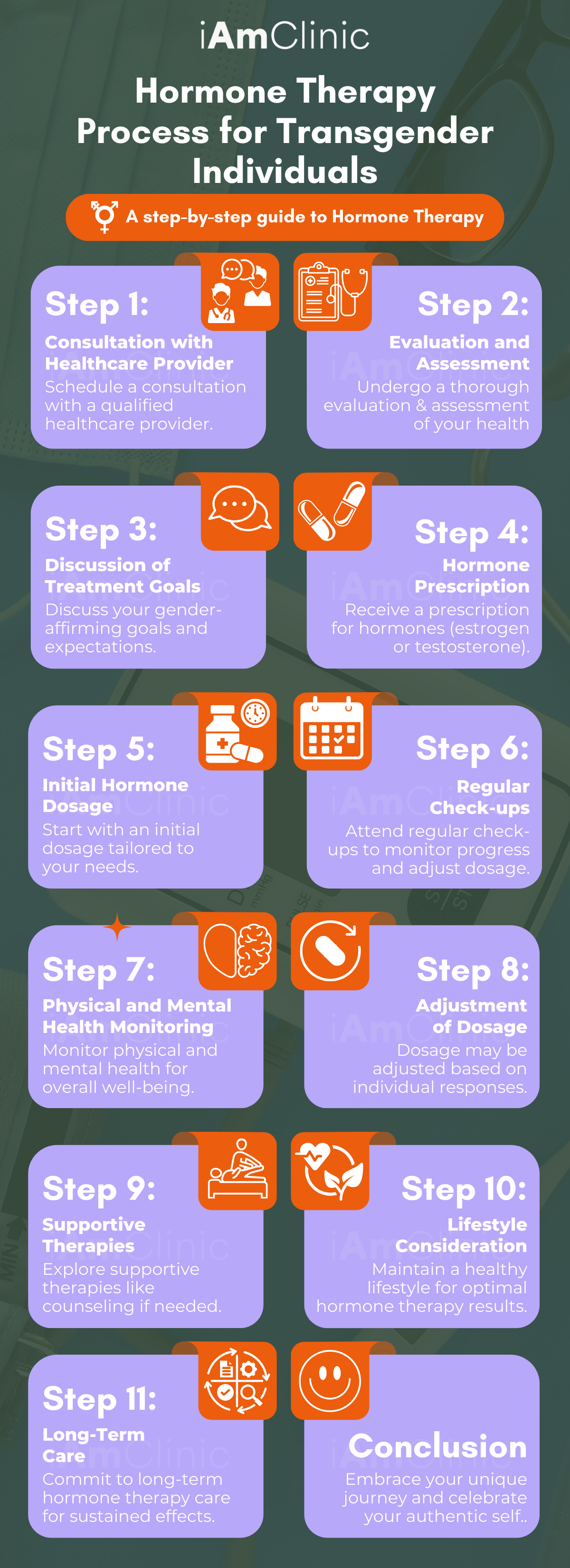Table Of Contents
Can You Be Transgender Without Surgery / Transitioning
Navigating Gender Transition: Social and Physical Dimensions
Hormone Therapy in Gender Transition: Enhancing Physical and Mental Well-Being
Tailoring Gender Transition: Exploring Hormone Dosage Options
Exploring Gender Transition Options: Hormone Therapy and Puberty Blockers
Harmonizing Gender Expression: Exploring Transgender Voice Modification
Can You Be Transgender Without Surgery / Transitioning
Can you be transgender without surgeries or transitioning? Yes, and transitioning might be what’s right for you. Let’s start by taking a look at a few key definitions: 1) sex, 2) gender, and 3) transgender:
First, sex involves biological differences such as genitalia, hormones, and chromosomes and includes male, female and intersex.
Secondly, gender relates to the social constructs assigned to the sexes, such as gender roles, behaviors, gender expression, and the experience of gender.
And last, but certainly not least, someone who identifies as transgender, simply means the experience of gender and/or personal identity doesn’t align with their sex assigned at birth.
Navigating Gender Transition: Social and Physical Dimensions
So, as we look at the pragmatics of the definitions, yes you can identify as trans without transitioning. Acknowledging that your gender identity is trans does not require anything other than recognizing how your body understands itself- from within.
What makes this question complex is there are various meanings for transitioning, and those meanings vary from person to person.
1. Social Transitioning
How to be transgender without surgery? Some trans individuals choose to socially transition which includes aligning their gender expression with their internal gender experiences. This might include changing their name and pronouns.
For example, Anna may change her name to Andrew, start wearing masculine-styled clothing, and use he/him pronouns. Andrew, in this example, may also decide to wear a binder and rock a masculine hairstyle. Such changes may suffice in terms of finding congruence between what the person knows about themselves and how they want to express that knowing. For this individual, their trans identity is just as valid as someone who undergoes a physical transition.
2. Physical Transitioning
While some people may prefer to only socially transition, others want to change their expressions and their sex. This would include going on hormones and having surgery to change their physical appearance. Having said that, it is possible to go on hormones without having any surgery, and that is okay!
Navigating Social Transition Challenges
Transitioning socially can be exciting but also challenging. Here are some tips for handling potential issues:
- If your family or friends react negatively, be patient and point them toward resources that can educate them. But set boundaries if needed.
- In public spaces, know your rights. Be safe but don’t compromise being your authentic self. Have a support system.
- If facing discrimination at work, consult HR and LGBTQ organizations to explore options. Seek legal counsel if needed. Our career coach can also help you learn more about your rights and risks.
- If you experience imposter syndrome, know many others feel the same. Don’t rush your transition. Make small changes at your own pace.
Hormone Therapy in Gender Transition: Enhancing Physical and Mental Well-Being

Hormone therapy is a popular option in the transition process for many transgender individuals, providing both physical and mental health enhancements. This form of treatment involves the administration of hormones that align with an individual’s gender identity. For trans women (male-to-female), estrogen is typically the primary hormone administered. This helps develop feminine secondary sexual characteristics, like the development of breast tissue. Conversely, trans men (female-to-male) usually receive testosterone to induce masculine traits, like facial hair for some. It’s worth noting that hormone therapy should be personalized to each individual’s needs and overseen by experienced endocrinologists. Research also indicates that hormone therapy can improve mental health outcomes among transgender people, reducing symptoms of depression and anxiety.
In addition to hormone therapy, many transgender individuals benefit from holistic approaches like somatic therapy, which helps address the emotional and physical impact of the transition process. Somatic therapy focuses on the connection between the mind and body, providing techniques that can help manage the stress, anxiety, and trauma often experienced during gender transition. At Somatic Therapy Partners, the emphasis on nervous system regulation and body-based healing can further enhance the mental health benefits that hormone therapy provides, offering a comprehensive approach to well-being. Learn more about somatic therapy here.
Tailoring Gender Transition: Exploring Hormone Dosage Options
There are some who want to take a full does of either estrogen or testosterone. Doing so will have more of a dramatic effect on the body- more significant change more quickly. There are other options, like micro-dosing, where one might take a small dose of testosterone or estrogen, creating subtle change over a longer period of time. Some trans people use micro-dosing HRT as a way of easing into the process until they feel comfortable. Once they slowly adjust to the effects they might increase their doses. Others might find that micro-doses of HRT is the perfect amount, meaning that small doses create the desired affects on their bodies. Some in transitioning find comfort just in knowing that the appropriate hormones are in their circulatory systems, and this—for some—is the desired degree of version of transitioning.
Exploring Gender Transition Options: Hormone Therapy and Puberty Blockers
Hormone replacement therapies are not used as a one-size-fits-all approach, so it is important to clarity on how HRT might be used to help you find comfort and peace. This can be done in working with an Endocrinologist and a therapist.
Another important form of transitioning might be slowing down one of the body’s major processes, puberty. Puberty blockers are a type of medical intervention that can be used to temporarily halt the onset of puberty. They work by suppressing the hormones—testosterone and estrogen—that lead to the development of secondary sexual characteristics. This can provide trans individuals more time to explore their gender identity and make decisions about further treatment options. Puberty blockers might also prevent voices from dropping in tone, the development of Adam’s apples, the growth of breast tissue, or the prevention of facial hair from growing. In this light, puberty blockers do not only stall puberty to allow for more inner-personal exploration, but they might protect a trans teen from dysphoric experiences and/or developmental processes.
Although generally considered safe, puberty blockers do have some potential side effects, and their impact on bone development and height is not yet fully understood. It’s important to remember that this is just one of many options available, and any decision about treatment should be made in consultation with experienced healthcare providers.
Understanding Non-Binary and Genderfluid Identities
While this guide focuses on binary transitioning, it’s important to acknowledge non-binary identities too. Non-binary is an umbrella term for genders outside the male/female binary. This includes:
- Genderfluid – Shifting between genders
- Agender – Not relating to any gender
- Bigender – Both male and female
- Demigender – Partially one gender
Like binary trans folks, non-binary people may socially and/or medically transition. However, their transitions often look different based on their individual needs and expression.
Harmonizing Gender Expression: Exploring Transgender Voice Modification
And of course, this paves way for considering transgender voice modification, also known as voice therapy. Voice modification is a form of training designed to help transgender individuals align their voice with their gender identity. This process, often facilitated by Speech-Language Pathologists (SLPs) with specialized training, involves various techniques to masculinize or feminize an individual’s voice and communication style. Although very new, there are very few medical doctors who perform surgeries to modify the pitch and tone of the vocal chords. Both of these forms of transitioning aim is to help individuals express themselves in a manner consistent with their gender. Voice therapy and vocal chord modifications can be seen as part of gender- and identity-affirming care, aimed at reducing gender dysphoria and improving self-confidence. It’s important to remember that this is just one of many options available to transgender individuals during their transition process, and it should be considered in line with each person’s unique needs and circumstances.
Gender Transition Choices: Voice Modification and Individual Journey
Many trans individuals question whether they will feel more comfortable, healthy, and peaceful after transitioning. It is very important to consider all options that are available. Taking the time to explore what might feel right, what won’t, what transitioning might mean to you, and learning about how transitioning might need to take place for your unique circumstances and unique gender identity are all very important. Every person’s journey and experience will be unique to them.
What if you don’t want to make any changes? That is completely up to you, and your trans identity is just as valid as individuals who choose to transition. This may sound confusing for some people as it is fairly typical for trans individuals to want to transition in some way, but it doesn’t mean it’s a requirement for you. Transitioning is a process that can take many big steps or several small ones. It might entail little changes and not big ones. Transitioning might be designed to help you express a completely different personhood for some and it might be used to make small adjustments for others. Gender identity is complex and taking time to learn about all of your personal nuances will be a great way to help find the right way to transition. And remember, we are here to help you with your journey
Medical Transition Options
In addition to social changes, medical transitioning includes:
- Hormone therapy – Estrogen for trans women, testosterone for trans men
- Puberty blockers – For youth to delay body changes
- Gender affirmation surgeries – Top surgery, bottom surgery, facial surgery
It’s important to work with doctors and therapists to determine which options will help you strike your specific version of gender euphoria. Not all trans folks medically transition. Do what feels right for you.
Further Learning and Support
Here are great resources to continue exploring:
- PFLAG – Education and support for LGBTQ people, families, and allies
- The Trevor Project – Crisis intervention and suicide prevention for LGBTQ youth
- Trans Lifeline – By and for the trans community
- Local LGBTQ+ centers – For in-person community and events.


